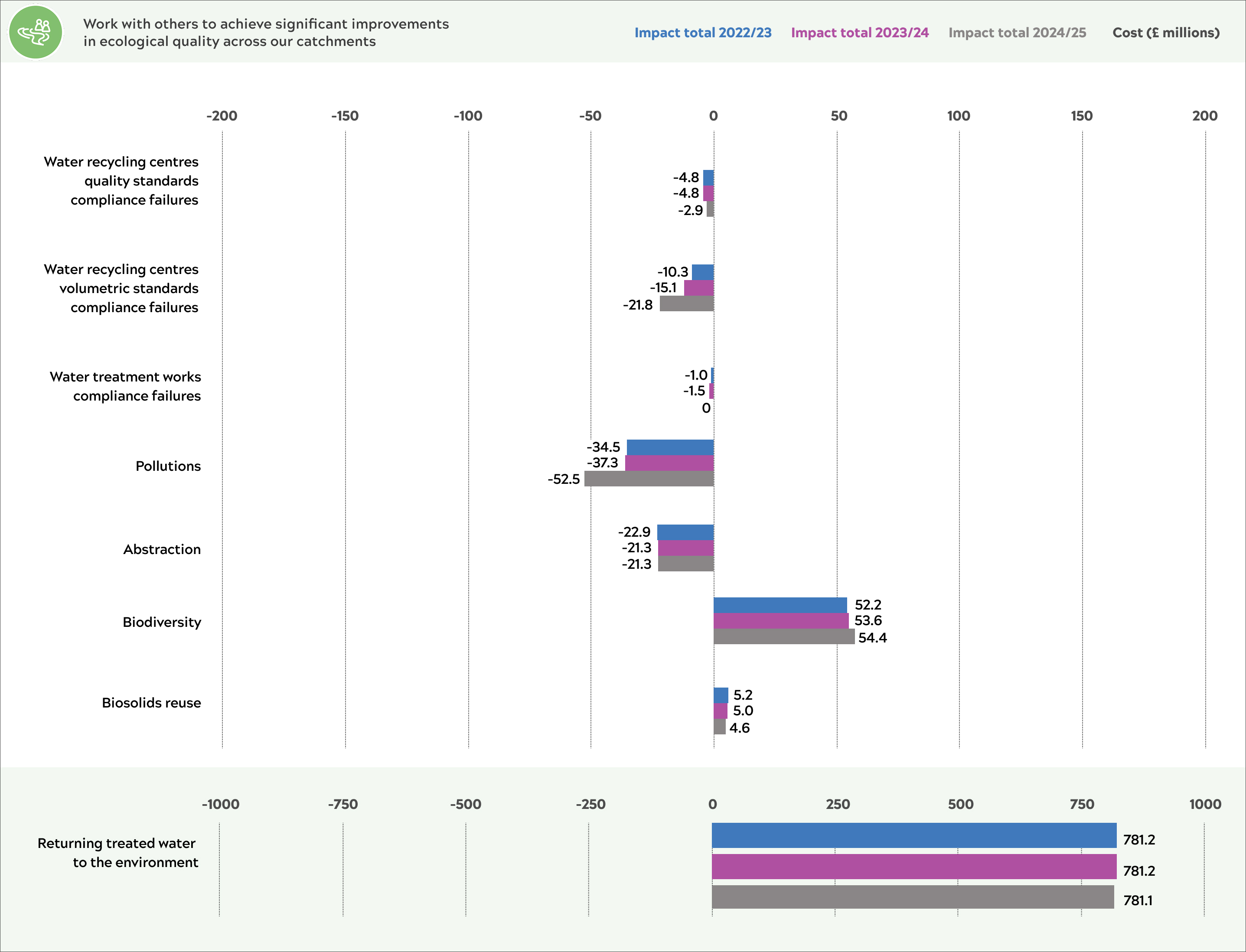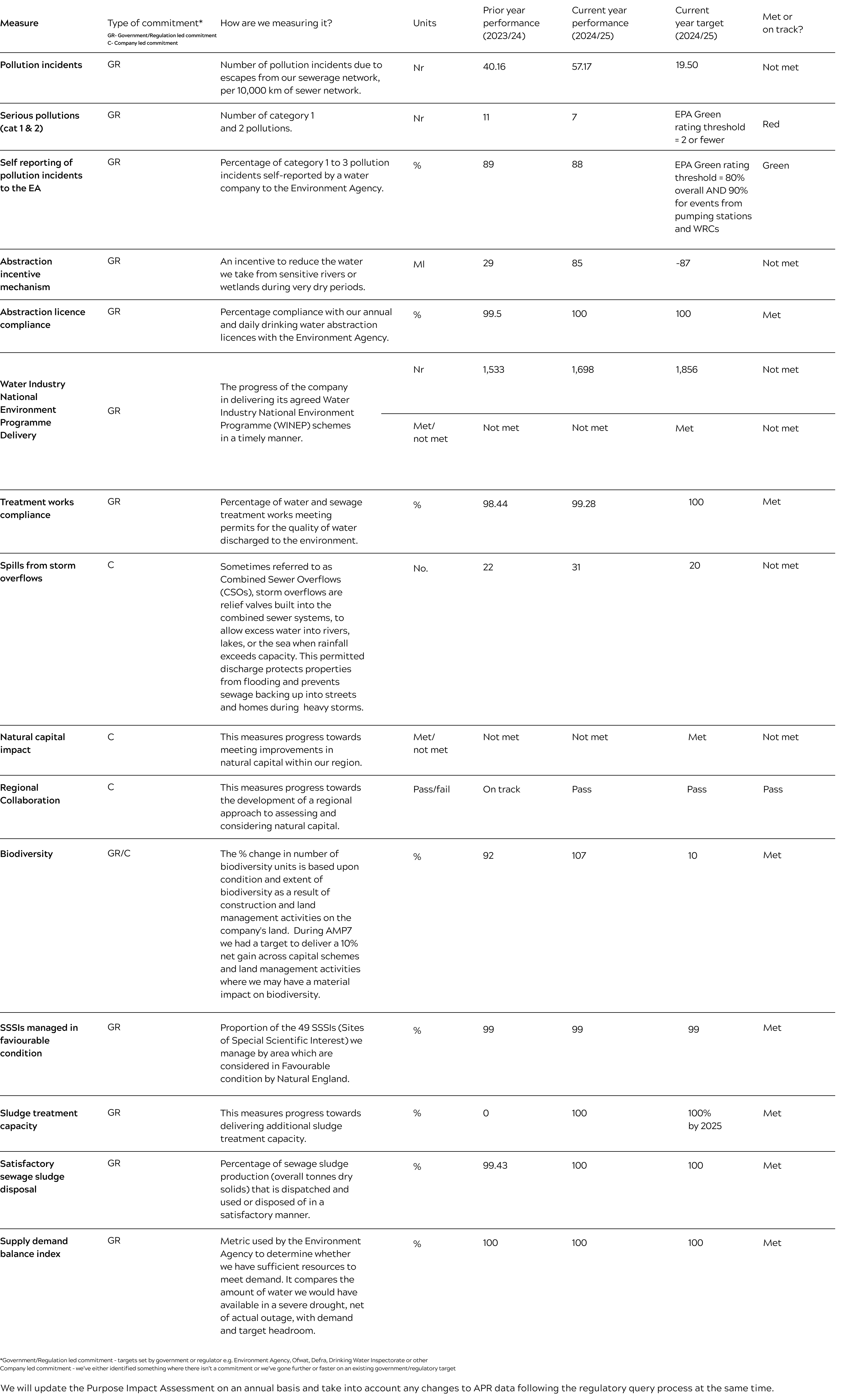{{selectedAlertBand.alertDescription}}
{{selectedAlertBand.incident.heading}}
Message last updated - Tuesday 16th December 2025
{{selectedAlertBand.incident.heading}}
Message last updated - Tuesday 16th December 2025
Message last updated - Tuesday 16th December 2025
{{selectedAlertBand.alertLinkText}} {{selectedAlertBand.alertLinkText}}
For further updates subscribe

We're prioritising investments to support river water quality and deliver more nature-based solutions to enhance natural capital in the region. Areas where we're having the biggest positive impact.
We’re also working hard to tackle areas where we have a negative impact. Which includes reducing storm overflow spills and improving our pollutions performance. We’re also working in partnership with other sectors to mitigate the impacts of flooding and diffuse pollutions. Underpinning all of these schemes is our commitment to significantly reducing the amount of water taken from the environment and mitigate the impacts of climate change on the environment.
Some of our key commitments to 2030 include:
You can find out more about our ambitions to 2030 and 2050 in our AMP8 Business Plan proposals.
Our Impact

The measures in this section of the assessment cover the impact of us doing the basics right. Returning treated water to the environment safely and working to protect and enhance the land, water, air and wildlife in our region. As well as the negative impacts when we don’t get it right.
Some of these measures are made up of a suite of sub metrics explained below and full details can be found in our methodology.

Returning treated water to the environment
The majority of the time, we treat and return water back into the environment to stringent quality standard. However, when we don't this can lead to compliance failures and pollutions that can have a significant impact. Our Water Recycling Centre performance against quality standards has improved this year while at the same time having tighter standards required as part of the Water Industry National Environment Programme. On volumetric standards, our negative impact has increased this year after a very wet winter in 2024. This led to higher flows in the catchment reflected in our Dry Weather Flow numbers. We've increased the number of assessments sites we monitor for Full Flow to Treatment from 15 sites in 2022 to 100 sites in 2024. While it appears our impact is worsening, this is in part because we have a greater understanding of our performance from the improved data and monitoring.
We've invested significantly over the past 18 months to address our pollution performance. Due to the lag associated with our risk reduction activities we are yet to see improvements fully realised. In 2024/25 we saw a higher number of Total Pollutions than we did in the year prior, although we achieved a 36% reduction in Serious Pollutions. Our ambition is to achieve zero untreated escapes from our assets by 2050 and we’re investing heavily to improve our performance. More detailed information can be found in our Pollution Incident Reduction Plan.
Abstraction and improving the health of rivers
We're focused on improving the quality of water we return to the environment. Alongside this, are making progress to reduce abstraction. Reducing abstraction is one of the biggest things we can do to maintain ecological health. It means we can leave more water in environmentally sensitive sites – such as chalk streams – especially as demand for water grows. Our compliance on abstraction licence limits (annual and daily) was 100% this year and 99.5% in 2022/23 and 2023/24. We're working to reduce our abstraction from environmentally sensitive sites by a further 89 megalitres a day (Ml/D) and expect to close a further two abstraction sites in the Norfolk Broads. More in our Long Term Delivery Strategy and Water Resources Management Plan (WRMP24).
There are many complex factors at play when it comes to river health. Improvements will take time, investment and collaboration. Through our ‘Get River Positive’ initiative, launched in 2022, we're leading on a range of multi-sector projects. These projects vary from river restoration to creating digital ecological twins, to unlocking more opportunities for bathing waters. We work with a range of beneficiaries – from the agricultural community to landowners and local citizen scientists. See our latest River health report (pages 44-47 in our Annual Integrated Report) for more details on the collaborative work we're undertaking to improve rivers.
Increasing biodiversity and enabling nature recovery
We have a responsibility to protect the precious habitats and species in our region.
Biodiversity Net Gain is one way we're enhancing natural capital in the region. Alongside protecting the 49 Sites of Special Scientific Interest (SSSIs) we're responsible for. 99% of our SSSIs are in favourable condition.
Working in partnership
To maximise opportunities to deliver nature-based solutions, our Advanced Water Industry National Environment Programme (A-WINEP) will see us develop new ways of collaborating with environmental organisations, communities and citizen scientists. To understand the outcomes most important to local communities in a specific area. We believe we can and will achieve most by aligning our own investment with other funding such as agricultural grants, environmental markets, and wider corporate and philanthropic finance. A key example of this is Future Fens: Integrated Adaptation (FFIA), where in 2021, a multi-sector taskforce came together with a shared aspiration for the Fens to be an exemplar for landscape-scale integrated water management and resilience planning.
Biosolids reuse
We recycle the biosolids produced as part of our sludge treatment process to agricultural land as an alternative to the use of artificial fertiliser and valuable source of nutrients. All of our sludge production is treated to the BAS (Biosolids Assurance Scheme) standard, and adheres to ISO 14001 (Environmental Management System) standards. Both of which are UKAS accredited. The landbank available for recycling this material has progressively reduced in recent years, principally due to tighter nutrient legislation in agriculture. We anticipate that the landbank available for biosolids recycling will reduce further in future, so our bioresources strategy for 2025-2050 includes exploring and developing alternative recycling options. We’re working with Firefly Green Fuels, a spinoff from Green Fuels Research and Haltermann Carless, to provide biosolids for an exciting new project: sustainable aviation fuel. See our Annual Integrated Report for more details.
Our performance and commitments
Our commitments and current performance around our ambition to work with others to achieve significant improvements in ecological quality of catchments are shown in the table below. Further details can be found on pages 30-36 in our Annual Integrated report and our Annual Performance Report.
